|
Home > Camera Reviews > Sony RX10

Sony Cyber-shot DSC-RX10
What's Hot: Super video quality, very good image quality, fast constant aperture Zeiss f/2.8 lens, long 8.3x zoom range, full manual controls.
What's Not: Expensive, though arguably worth it for what you get.

Reviewed March 26, 2014 by Lisa Gade, Editor
in Chief (twitter: @lisagade, Instagram lisagadeMTR)
Sony has done some amazing things with digital cameras in the past five years, from the groundbreaking NEX-5 mirrorless ILC (interchangeable lens camera) that was barely bigger than a point and shoot, to the tiny RX100 and RX100 II point and shoots that take photos nearly as good as an entry to mid-level consumer DSLR. Today we look at another novel Sony digital camera, the Cyber-shot DSC-RX10. You could call this a bridge camera, but it's more than that. It looks and works like a compact DSLR but the lens is fixed (you can't remove it). But unlike most bridge cameras, you're not compromising on the image processor, manual controls and pro-oriented ports like 3.5mm stereo mic and headphone jacks and an uncompressed HDMI port that can stream lossless content to a computer or video recorder.
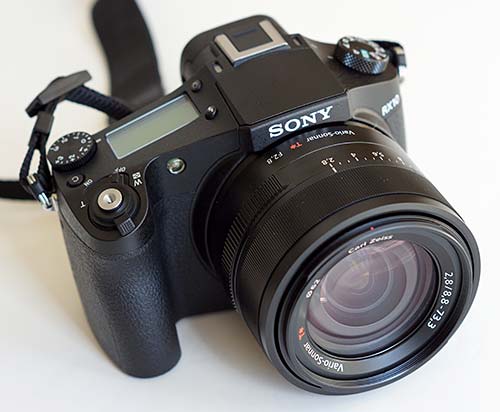
The RX10 weighs 1.65 lbs. so it's no lightweight and is similar in size to Sony's a65 compact DSLR with an APS-C sensor. It has a magnesium alloy body with a leather-style covering and it's weather and dust resistant. It looks and feels like a quality camera and it's large enough to provide a good grip and set of controls. The camera has a bright 3" articulating LCD (up and down, but not sideways) and a wonderful XGA electronic viewfinder (EVF) as well as the usual monochrome LCD up top for basic status info. There's a built-in flash and Sony's multi-interface shoe for flashes and external microphones (you can use the 3.5mm mic port to keep the hot shoe available for external flashes). The camera has an SD card slot that's compatible with UHS-1 cards and Memory Stick Pro Duo cards. The RX10 has built-in stereo mics that are surprisingly good quality and you can use hotshoe or 3.5mm jack mics.
What Makes it Special, and Possibly Worth the Price
So what makes the Sony RX10 so impressive? For those who want SLR-like handling and quality, but don't want to buy a bevvy of heavy and expensive lenses, the $1,299 RX10 is hard to beat. Why? It has a very fast long zoom lens with an impressive constant f/2.8 aperture. That sort of lens for a DSLR will cost as much as the RX10 itself. The f/2.8 Carl Zeiss Vario-Sonnar T* 24-200mm (35mm equivalent) does the job of several lenses in terms of zoom range and it's much faster (wider aperture) than the horrid kit lenses included with many otherwise respectable cameras. It's also equally good at shooting full HD video with many design nods towards video shooting, including 1080 at 24p/60i/60p in AVCHD format, a zoom trigger on the body that activates the smooth motorized zoom, 3.5mm mic jack, zebras for over-exposure indication, full real time manual control over recording and the new BIONZ X processor (also used in the Sony Alpha A7 and A7R) that samples the full sensor when recording video (sampling the full sensor is a big deal since still cameras skip lines to avoid bogging down the processor). We used the RX10 to shoot the intro for our video review below, and you'll notice the intro is sharper with less motion blur and artifacting compared to our fairly high end Canon Vixia camcorder that we used to shoot the outro.
Pixel Peepers Will be Pleasantly Surprised
The Sony RX10 uses the same 1" 20.2MP Exmor R sensor with BSI as the Cyber-shot RX100 and RX100 II. That's much larger than a point and shoot sensor, but significantly smaller than a consumer DSLR's APS-C sensor. The RX10 makes up for the smaller sensor with backside illumination for improved low light shooting and the fast lens that gets more light to the sensor than the average SLR zoom. Will it beat a good APC-C or full frame DSLR with an f2.8 prime or zoom lens? Of course not. But it can come surprisingly close to APS-C or micro 4/3. If you're a pixel peeper that zooms in to 100%, you can see more fine detail on a full frame or APS-C shot (less so with micro 4/3). But for the rest of us who view an image as an image and don't do such pixel snooping, it's a good enough camera to satisfy enthusiasts, pro journalists, vacation snappers visiting that "special place" and travel photographers. If you make your living from high quality prints and enlargements as do wedding photographers, Nat Geo photographers and the like, then you'll obviously opt for a serious full frame DSLR; that's not the target audience for this particular Sony.
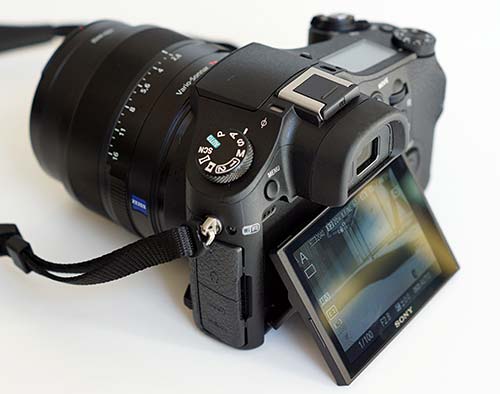
I'd say the lens is where most of your money is going, and honestly that's often the case when investing in a good DSLR or ILC system- the glass is important. This is an extremely sharp lens that captures plenty of color, has very good contrast and dynamic range with shadow detail for a 1" sensor. Distortion at each end of the zoom range is minimal, thanks in part to good correction in the camera's software. The Zeiss T* coated lens has 14 elements in 11 groups (7 aspheric) and 7 rounded aperture blades. Bokeh is pleasing with a mostly round and smooth look and you can get some good bokeh at the tele end with a wide aperture. Since this is a 1" sensor, you won't get the creamy and dreamy bokeh of a full frame sensor camera, but you can do some nice depth of field tricks like blurring the background and foreground while keeping your central subject sharp (assuming 5-10 feet distance between the three focal elements). Macro focusing is reliable and you can get closer at the wide end, though most of us prefer shooting at the tele end. Honestly, you won't find a better lens on a bridge camera and it beats the kit lenses supplied with many ILCs and SLRs. In two weeks of shooting, I never wished I could switch to another lens since the quality and sharpness are so good and the range covered a wide variety of shooting situations from portraits to landscapes to capturing birds at a distance. Disclosure: I'm a picky lens snob and have rarely met a kit lens or bridge lens that I liked.
|
Deals and Shopping:
Advertisement
|
|
Sony RX10 Video Review
Sony RX10 Sample Photos
Click on the gallery below to see larger images.
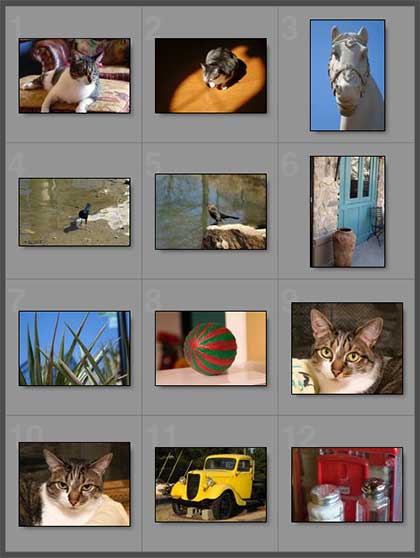
|
Advertisement
|
Video Heaven
Still cameras are great for photos and we shoehorn some of the more capable models into video cameras (the Canon EOS 5D mark III is a popular example). DSLRs require some serious added gear to make them amenable to video shooting--focus pullers, racks and external viewfinders to check focus. Camcorders and even prosumer $3,000 video cameras take OK photos but nothing that would satisfy even a non-pro demanding photographer. The Sony DSC-RX10 is the best of both worlds: it takes very impressive photos with plenty of zoom range, manual controls and a fast aperture at your disposal. It's equally and quite frankly mind-bogglingly great at shooting video. We shot video at the higher 1080 60i 24mbps rate and 60p 28 mbps and this is some of the best footage we've seen on anything that costs $5,000 or less (including video cameras). Unless you hate AVCHD with a passion, I think you'll be impressed and pleased with the results. Thanks to the full frame sampling (near 5k) moire is reduced, though not eradicated. Rolling shutter is inescapable, but we saw little of it.
Focus for Photo and Video
The 25 point autofocus system is quick with much less hunting than we saw on the Canon 70d and Sony Alpha a65 with their respective kit lenses. The lens is extremely quiet, and the stereo body mics didn't pick up its noise. Speaking of silence, there's a switch on the underside of the lens that turns off the aperture ring click. And yes, it has an aperture ring, just like lenses of old. You can switch aperture on the fly when recording video and make all manner of adjustments (unless you're shooting in full auto mode). The focus ring is near the end of the barrel and you can use direct manual focus with visual aide to tweak autofocus or use manual focus if you prefer. Our only complaint is the fly by wire zoom: there's sometimes a little lag before zoom begins when using the lens ring, and it takes quite a few turns to go full zoom. The zoom lever on the body is more immediate and quicker since you're not rotating away at a ring. When shooting photos I used the zoom ring, but for video I quickly gave up on that and used the zoom lever on the body. When using the lever, electronic zoom is smooth and visually pleasing in video. The lens has optical image stabilization (Steady Shot in Sony lingo) and you can enable/disable this independently for photo and video. If you work using a tripod when shooting video, you'll want to turn it off to avoid stabilization overcompensation since the RX10 doesn't seem to have a tripod sensor.
The Usual Modes on Board, JPEG and RAW Too
The interface and controls are all Sony Alpha, and that's a good thing: there's none of the awkwardness of the Sony NEX series. The left dial controls shooting modes: iAuto, manual, aperture priority, shutter priority, full manual, video, panorama and creative style modes. The top right dial provides quick access to EV (-3 to +3 in 1/3 EV steps) and there are buttons for AE lock, Fn, movie recording, playback and the usual DSLR style rotary dial on the right. The controls and layout are DSLR rather than point and shoot, fitting of such a capable camera that's intended for prosumers rather than those who desire little manual control over the camera. The usual top LCD provides quick status info and there's a button to pop up the small built-in flash (it won't self-deploy, so you'll have to pop it up first if you think the camera might make use of it). The RX 10 has Sony's Multi-Interface Shoe up top, WiFi for image transfer and remote control when shooting photos and NFC to make WiFi connections to smartphones and tablets easier.
More Feeds and Speeds
The camera can shoot up to 10 fps for photos, and it has the expected RGB histogram in addition to zebras as well as a level. Max shutter speed is 3200 and max aperture is f/16. That's not a very high max aperture but the camera makes up for it with an internal 3 stop neutral density filter. Max ISO is 12,800 and we found that photos up to 6400 showed very low noise with some help from Sony's noise reduction that's just a little overzealous at times (that's what RAW is for!). All told, we were fairly pleased with JPEG rendition in-camera, and found it more balanced in terms of sharpening and noise reduction than in the Sony Alpha 7 full frame ILC. For those who find the sharpening a little overdone, RAW mode is the way to go. We were able to pull a little more color and shadow detail using RAW developed in Photoshop CS6 or Lightroom.
Bridge cameras don't usually get pro features, but this is no normal bridge camera. In addition to stereo mic in and headphone out, you get uncompressed video out over (micro) HDMI and the camera can send still photos up to 4K resolution to a 4K TV or monitor. The 3" rear LCD is bright and viewable outdoors. It's an articulating panel that pops up and out but doesn't move sideways or swivel down below the body like some Sony Alpha cameras.
Battery Life
This is a little insulting for a camera this expensive: there's no battery charger in the box (the same is true of the Sony RX100 and A7). You get a USB to micro USB cable for charging the battery while in the camera via your computer and a USB charger like that used for a smartphone. Granted, USB charging is handy when traveling but not so much in a studio, and you can't charge the camera while using it since it changes to mass storage mode (even when connected to the USB charger). The camera uses the same NP-FW50 1080 mAh Lithium Ion battery as Sony NEX and A7 cameras and you can use the W battery charger included with NEX cameras as a result. Sony quotes 420 photos on a charge when using the LCD or 330 when using the viewfinder (yes, the little screen uses more power than the big one). It can shoot around 2 hours of AVCHD video on a full charge in our tests.
Conclusion
Think of the Sony Cyber-shot RX10 as a fix lens Sony Alpha camera rather than the usual Cyber-shot consumer snapper. It has the same intuitive and powerful Alpha controls and settings, very impressive image quality for a 1" sensor and simply stellar video quality. The Zeiss f/2.8 stabilized lens is a dream come true in terms of long zoom range, wide aperture and quality. Sony says most consumer DSLR buyers don't change lenses, and with this lens, you'll likely not feel a need to swap lenses. No, it's not a pro full frame camera, but it's also significantly less expensive, smaller and lighter. Yes, it costs as much as a good DSLR with kit lens, but the RX10's lens is much better than the average kit lens with better video recording too. If you're in the market for the best jack of all trades camera for photo and video with a versatile and fast long zoom lens, full manual control and good build quality, the unique Sony RX10 is it.
Price: $1,299
Website: www.sony.com
More Camera Reviews:
Sony A7 Review
Sony a6000 video review
Sony RX100 IV Review
Fujifilm X-T10 Review
Panasonic Lumix LX100 Review
Canon PowerShot G7X Review
Canon EOS 6D Video Review
Sony NEX 5 Review (original NEX model) |
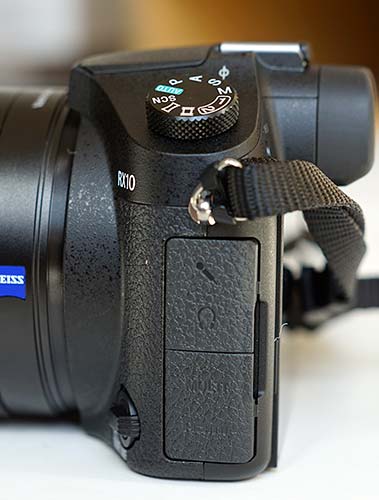
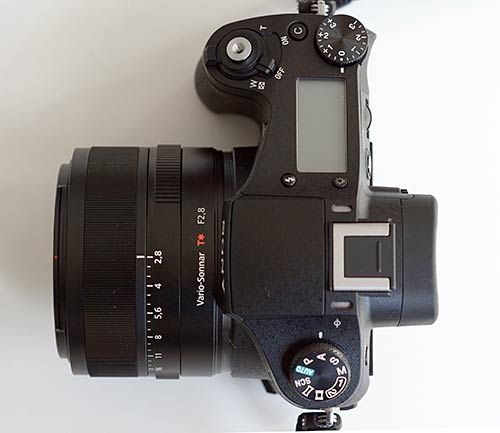
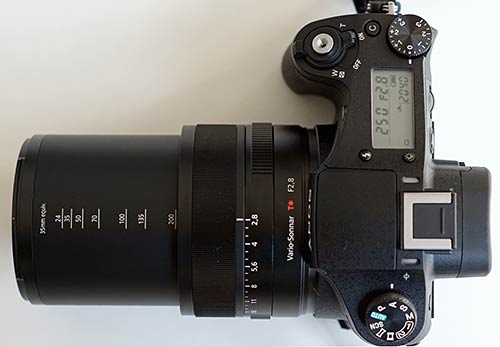
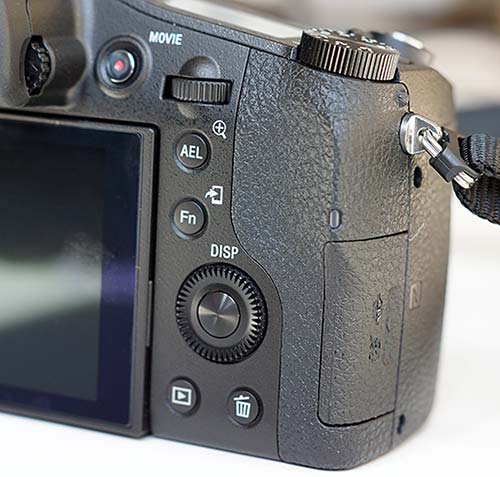
|
|
Specs:
Imaging Sensor:
Pixel Gross : 20.9M pixels (approx.)
Color Filter System : RGB primary color filters
Effective Picture Resolution : 20.2M pixels (approx.)
Imaging Sensor : Exmor R(R) 1.0" CMOS sensor (13.2 X 8.8mm) (3:2 aspect ratio)
Processor : BIONZ X image processor
Lens:
Optical Zoom : 8.3x (Optical Zoom during movie recording)
Lens Type : Carl Zeiss Vario-Sonnar T*, 14 elements in 11 groups (including 7 aspheric elements)
Aperture : F2.8 constant
Aperture Blade : Iris diaphragm (7 blades)
Focal Length (35mm equivalent): 24-200mm
Digital Zoom : Still Image: 20M approx. 66x / 10M approx. 93x / 5M approx. 133x / VGA approx. 249x (including Optical Zoom) Movie: 66x (including Optical Zoom)
Clear Image Zoom : 16.6x (including Optical Zoom)
Interface:
NFC : Yes (NFC Forum Type 3 Tag compatible, One-touch remote, One-touch sharing)
Memory Card Slot : Dual compatibility slot: Memory Stick PRO Duo(TM)/Pro-HG Duo(TM)/PRO-HG HX Duo media - SD, SDHC and SDXC memory cards
HD Output : HDMI (Type D micro)
Wi-Fi : Yes
Accessory Shoe : Multi Interface Shoe
Tripod Mount : Yes, 1/4" (20 thread count)
PhotoTV HD : Yes, with BRAVIA Sync enabled HDTV and HDMI cable
USB Port(s) : USB 2.0 Hi-speed (mass-storage, MTP)
BRAVIA Sync : Yes, via HDMI with compatible BRAVIA HDTV (link menu)
Microphone Input : Yes (3.5 mm Stereo minijack or Multi Interface)
Power:
Battery Type : InfoLITHIUM W series NP-FW50 (7.7V)
Number of Still Images : Approx. 420 images with LCD monitor (CIPA standard)
Battery Capacity : 1080 mAh
Weights and Measurements:
Dimensions: Approx. 5-1/8 3-1/2 4-1/8 (129.0 x 88.1 x 102.2 mm) (W/H/D)
Weight: With battery and Memory Stick PRO Duo Approx. 1 lb. 12.7oz. (813 g)
Recording:
Panorama Still Image Size : Horizontal wide (12416 x 1856 / 5536 x 2160), Horizontal standard (8192 x 1856 / 3872 x 2160)
Audio Format : Dolby Digital (AC-3) / MPEG-4 AAC-LC
Video Format : AVCHD Ver. 2.0 / MP4 (MPEG-4 AVC (H.264))
Video Mode : AVCHD: 28M PS (1920 x 1080, 60p) 24M FX (1920 x 1080, 60i) 17M FH (1920 x 1080, 60i) 24M FX (1920 x 1080, 24p) 17M FH (1920 x 1080, 24p) MP4: 12M (1440 x 1080, 30 fps) 3M VGA (640 x 480, 30 fps)
Color Space : sRGB, AdobeRGB, xvYCC standard (x.v.Color when connected via HDMI cable) compatible with TRILUMINOS(TM) color
Still Image Size 16:9 : L:17M (5472 x 3080) / M: 7.5M (3648 x 2056) / S: 4.2M (2720 x 1528)
Still Image Size 3:2 : L: 20M (5472 x 3648) / M: 10M (3888 x 2592) / S: 5.0M (2736 x 1824)
Still Image Mode : JPEG (Standard, Fine), RAW, RAW+JPEG
Media Types:
Memory Stick Duo, Memory Stick PRO Duo, Memory Stick PRO Duo (High Speed), Memory Stick PRO-HG Duo, Memory Stick XC-HG Duo, Memory Stick Micro, Memory Stick Micro (Mark2), SD Memory Card, SDHC Memory Card (UHS-I), SDXC Memory Card (UHS-I), microSD Memory Card9, microSDHC Memory Card9, microSDXC Memory Card
|
|
|
|








